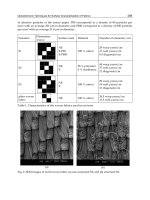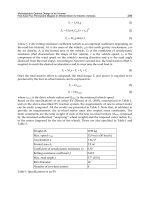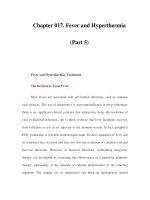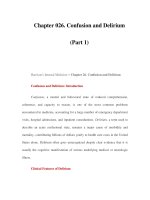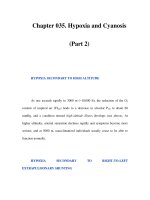Chapter 046. Sodium and Water (Part 11) pdf
Bạn đang xem bản rút gọn của tài liệu. Xem và tải ngay bản đầy đủ của tài liệu tại đây (12.51 KB, 5 trang )
Chapter 046. Sodium and Water
(Part 11)
Potassium: Introduction
Potassium Balance
Potassium is the major intracellular cation. The normal plasma K
+
concentration is 3.5–5.0 mmol/L, whereas that inside cells is about 150 mmol/L.
Therefore, the amount of K
+
in the ECF (30–70 mmol) constitutes <2% of the total
body K
+
content (2500–4500 mmol). The ratio of ICF to ECF K
+
concentration
(normally 38:1) is the principal result of the resting membrane potential and is
crucial for normal neuromuscular function. The basolateral Na
+
, K
+
-ATPase pump
actively transports K
+
in and Na
+
out of the cell in a 2:3 ratio, and the passive
outward diffusion of K
+
is quantitatively the most important factor that generates
the resting membrane potential. The activity of the electrogenic Na
+
, K
+
-ATPase
pump may be stimulated as a result of an increased intracellular Na
+
concentration
and inhibited in the setting of digoxin toxicity or chronic illness such as heart
failure or renal failure.
The K
+
intake of individuals on an average western diet is 40–120 mmol/d,
or approximately 1 mmol/kg per day, 90% of which is absorbed by the
gastrointestinal tract. Maintenance of the steady state necessitates matching K
+
ingestion with excretion. Initially, extrarenal adaptive mechanisms, followed later
by urinary excretion, prevent a doubling of the plasma K
+
concentration that
would occur if the dietary K
+
load remained in the ECF compartment.
Immediately following a meal, most of the absorbed K
+
enters cells as a result of
the initial elevation in the plasma K
+
concentration and facilitated by insulin
release and basal catecholamine levels. Eventually, however, the excess K
+
is
excreted in the urine (see below). The regulation of gastrointestinal K
+
handling is
not well understood. The amount of K
+
lost in the stool can increase from 10 to
50% or 60% (of dietary intake) in chronic renal insufficiency. In addition, colonic
secretion of K
+
is stimulated in patients with large volumes of diarrhea, resulting
in potentially severe K
+
depletion.
Potassium Excretion
(See also Chap. 272) Renal excretion is the major route of elimination of
dietary and other sources of excess K
+
. The filtered load of K
+
(GFR x plasma K
+
concentration = 180 L/d x 4 mmol/L = 720 mmol/d) is ten- to twentyfold greater
than the ECF K
+
content. Some 90% of filtered K
+
is reabsorbed by the proximal
convoluted tubule and loop of Henle. Proximally, K
+
is reabsorbed passively with
Na
+
and water, whereas the luminal Na
+
-K
+
-2Cl
–
co-transporter mediates K
+
uptake in the thick ascending limb of the loop of Henle. Therefore, K
+
delivery to
the distal nephron [distal convoluted tubule and cortical collecting duct (CCD)]
approximates dietary intake. Net distal K
+
secretion or reabsorption occurs in the
setting of K
+
excess or depletion, respectively.
The cell responsible for K
+
secretion in the late distal convoluted tubule (or
connecting tubule) and CCD is the principal cell. Virtually all regulation of renal
K
+
excretion and total body K
+
balance occurs in the distal nephron.
Potassium secretion is regulated by two physiologic stimuli—aldosterone
and hyperkalemia. Aldosterone is secreted by the zona glomerulosa cells of the
adrenal cortex in response to high renin and angiotensin II or hyperkalemia.
The plasma K
+
concentration, independent of aldosterone, can directly
affect K
+
secretion. In addition to the K
+
concentration in the lumen of the CCD,
renal K
+
loss depends on the urine flow rate, a function of daily solute excretion
(see above).
Since excretion is equal to the product of concentration and volume,
increased distal flow rate can significantly enhance urinary K
+
output. Finally, in
severe K
+
depletion, secretion of K
+
is reduced and reabsorption in the cortical and
medullary collecting ducts is upregulated.
Hypokalemia
Etiology
(Table 46-3) Hypokalemia, defined as a plasma K
+
concentration <3.5
mmol/L, may result from one (or more) of the following: decreased net intake,
shift into cells, increased net loss. Diminished intake is seldom the sole cause of
K
+
depletion since urinary excretion can be effectively decreased to <15 mmol/d
as a result of net K
+
reabsorption in the distal nephron.
With the exception of the urban poor and certain cultural groups, the
amount of K
+
in the diet almost always exceeds that excreted in the urine.
However, dietary K
+
restriction may exacerbate the hypokalemia secondary to
increased gastrointestinal or renal loss. An unusual cause of decreased K
+
intake is
ingestion of clay (geophagia), which binds dietary K
+
and iron. This custom was
previously common among African Americans in the American South.
